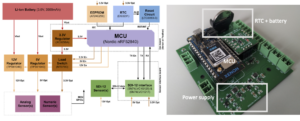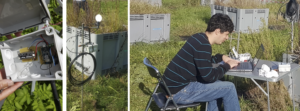AgriSense platform
Contact : Frédéric Weis
Plant health is a major issue in agroecology. The infection of a plant requires the confluence of three components
- the pathogen,
- the plant cover, in particular its growth and its physiological state,
- the climatic micro-conditions, such as relative humidity, air temperature and leaf wetness.
A wireless sensor network is a mesh network made up of of nodes capable of collecting physical quantities in the environment, converting them into digital data and transmitting them in an autonomous way. These nodes, often called “motes”, are on-board systems very constrained in terms of energy, CPU and memory capacity (<<100 kB of Flash and <10 kB of RAM). The extreme specialization and resource constraints usually make the use of an appropriate operating system (OS) unsuitable. As a result, the software running on this type of architecture is generally complex, very specific to the hardware and the context of use.
These limitations can now be overcome thanks to recent developments in the field of software mechanisms for IoT nodes. A low-cost microcontroller (MCU) offering mid-level resources (10 kB of RAM and 100 kB of Flash) and running on battery power, enables much more advanced functionalities to be deployed than rudimentary motes. This type of node can now work with a full operating system, providing application programming interfaces (APIs) that make it easy to develop, deploy and maintain software services directly at the node level. In addition, these nodes can interconnect and communicate with each other or with the Internet. Therefore, they are typically equipped with one (or more) network interface(s), and easily exploit a wide variety of low-power radio technologies (e.g., IEEE 802.15.4, Bluetooth/BLE), as well as essential IoT protocols (IPv6, 6LoWPAN, RPL and COAP).
The AgriSense platform is developed in the framework of a collaboration between EASE and the Demecology (Dynamics-Evolution-Modeling-Ecology) team of INRAe, which carries out work in plant epidemiology. The use of these very small objects for crop monitoring is promising. Our main research objective is to optimize the crop monitoring system from a data and energy perspectives, using generic software mechanisms as close as possible to the sensor node and introducing “intelligence” into the data collection mechanisms. To achieve this goal, we needed to have a stable, open, and future-proof platform and to overcome various technical obstacles. It is in this context that AgriSense, started in 2020, fits.
The hardware of AgriSense is based on very low cost/low power MCU. At the software level, we have used the free and open-source RIOT OS developed by a large community spread all over the world. RIOT implements all IoT standards and is based on a very open programming model.
The architecture of an “on-the-shelf” MCU for IoT is very generic. It offers a fairly limited number of I/O interfaces: GPIO port, UART, etc. However, the environmental sensors used for crop monitoring have very variable features: digital or analog, using specialized communication protocols (e.g. SDI12), and can be particularly energy intensive (e.g. dielectric sensors measuring wetness). To address this issue, we have defined a hardware architecture (see figure below) ensuring a stable link between the MCU and different types of sensors. This architecture is based on the design of a low-cost PCB, allowing to efficiently operate any type of sensors. This architecture is open (we are talking about an “open PCB”), very low cost, and can be easily adapted to different MCU architectures. At the end we showed that a generic MCU can perfectly meet the needs of environmental data capture for crop monitoring.
A set of libraries/drivers has been developed to connect the sensors to an MCU and drive them simply via APIs. In addition, the nodes run on small batteries and the field measurement campaigns can last several weeks. Particular attention has therefore been paid to very fine energy management. We are able to put the nodes and sensors in the deepest sleep mode as frequently as possible, and to wake them up whenever necessary. Some of these developments have been integrated into the official RIOT code.
This hardware and software architecture has been validated in a real field with different sensors. The experimentation lasted several weeks, until the end of 2021. We have evaluated different aspects: the robustness and stability of the nodes, the reliability of the information feedback, the energy consumption of each node.
AgriSense is currently used as part of a joint PhD with INRAe. Beyond agroecology, this open platform (at the hardware and software levels) can be used in various fields of application.






